Archaeologia Lituana ISSN 1392-6748 eISSN 2538-8738
2020, vol. 21, pp. 41–58 DOI: https://doi.org/10.15388/ArchLit.2019.21.3
Animal Bones and Bone Artefacts from the Viking Age Site of Tornimäe in Saaremaa
Heidi Luik
Archaeological research collection
Tallinn University
10 Rüütli St., 10130 Tallinn, Estonia
heidi.luik@tlu.ee
https://orcid.org/0000-0003-3428-3451
Liina Maldre
Archaeological research collection
Tallinn University
10 Rüütli St., 10130 Tallinn, Estonia
liina.maldre@ai.ee
https://orcid.org/0000-0001-7522-3485
Abstract. Archaeological investigations in Tornimäe in the eastern part of the island Saaremaa took place in 1963, 1968 and 2004. Artefacts found during the excavations are mainly dated to the Viking Age. Most of the finds are pottery shards, some metal artefacts were found, and also animal bones. The majority of mammal bones are bones of domestic animals. Nearly half of these are caprine bones, bones of cattle, pig and horse are less numerous. Wild game bones are few, only seals were hunted more often. Bird and fish bones are also represented. Only a few bone artefacts were among the finds, more fragments of bone items were found among the animal bones during the identification of osteological material. The bone artefacts found in Tornimäe are rather simple items which do not require special skills from the bone worker and could have been made by the users of these artefacts. The uses of bone artefacts are well suited with the location of the site at the seashore.
Keywords: Viking Age, Estonia, Island Saaremaa, animal bones, bone artefacts.
Gyvūnų kaulai ir kauliniai dirbiniai iš vikingų laikotarpio Tornimäe gyvenvietės Saremos saloje
Anotacija. Archeologiniai tyrinėjimai Tornimäe gyvenvietėje, esančioje rytinėje Saremos salos dalyje, vyko 1963, 1968 ir 2004 m. Didžioji dalis kasinėjimų metu aptiktų radinių yra datuojami vikingų laikotarpiu. Tarp radinių daugiausia buvo keramikos fragmentų, aptikta keletas metalinių bei kaulinių dirbinių, taip pat nemažai gyvūnų kaulų. Dauguma žinduolių kaulų buvo naminių gyvulių, beveik pusė kaulų buvo avių / ožkų, o galvijų, kiaulių ir arklių kaulų aptikta mažiau. Laukinių sausumos gyvūnų kaulų fragmentų vos keletas, dažniau medžioti tiktai ruoniai, be to, aptikta ir paukščių bei žuvų kaulų. Didžioji dalis kaulinių dirbinių rasta atliekant osteologinės medžiagos tyrimus. Jie gana paprasti, nereikalaujantys specialių kauladirbio įgūdžių ir greičiausiai yra pasigaminti pačių jų naudotojų, o dirbinių pobūdis ir paskirtis atspindi pajūryje įsikūrusios gyvenvietės specifiką bei poreikius.
Reikšminiai žodžiai: vikingų laikotarpis, Estija, Saremos sala, gyvūnų kaulai, kauliniai dirbiniai.
Received: 24/07/2020. Accepted: 14/09/2020
Copyright © 2020 Heidi Luik, Liina Maldre. Published by Vilnius University Press. This is an Open Access article distributed under the terms of the Creative Commons Attribution License, which permits unrestricted use, distribution, and reproduction in any medium, provided the original author and source are credited.
Introduction
The Tornimäe site is located in the eastern part of the island Saaremaa (Fig. 1). Nowadays it is about 2 km from the sea, but in the Viking Age the site was on the seashore, where, according to the contour lines, sea was deep enough to be navigated by sea-going vessels. The area of the cultural layer in Tornimäe is about 3.5 hectares (Mägi, 2005, fig. 1; 2010, p. 169–171, fig. 2–3).
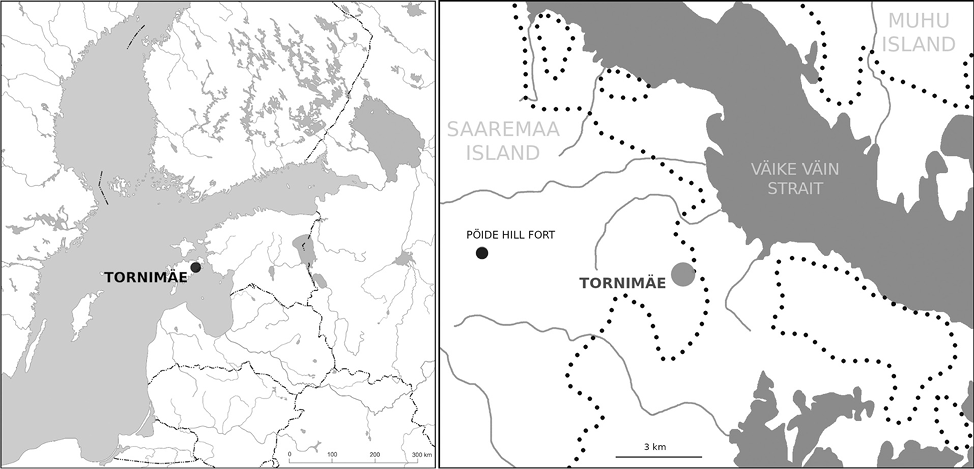
Fig. 1. Location of the Tornimäe site. Dotted line marks the approximate coastline 1,000 years ago. Map at left by Kersti Siitan, map at right by Heidi Luik after Mägi, 2010, fig. 2.
1 pav. Tornimäe gyvenvietės situacija. Taškeliai žymi kranto liniją prieš 1000 m. Žemėlapio kairėje autorius Kersti Siitan, žemėlapio dešinėje – Heidi Luik, pagal Mägi, 2010, 2 pav.
Archaeological investigations in Tornimäe took place in 1963, 1968 and 2004. In 1963, rescue excavations were carried out on an area of 160 square metres, supervised by Aita Kustin (Kustin, 1967; Mägi, 2005, p. 68, fig. 2; 2010, p. 170, fig. 3). Another rescue excavation, also by Kustin, was carried out in 1968, when about 1600 square metres of the settlement were destroyed by road building. This time only the soil piled up during road building was examined (Kustin, 1968). In 1997, several surface surveys were conducted in Tornimäe and the area of the cultural layer was located with phosphate-mapping (Mägi, 2005, p. 68–69; 2010, p. 170). In 2004, 80 square metres were investigated during archaeological excavation supervised by Marika Mägi (Mägi, 2005, p. 66 ff., fig. 2–5; 2010, p. 170–171). Aita Kustin (1967) interpreted the site as an ordinary settlement, in the opinion of Marika Mägi the site, located on the sea shore was used as a harbour (Mägi, 2002, p. 189, fig. 8; 2005, p. 66 ff., fig. 1, 2; 2010, p. 169–171, fig. 2, 3). Mägi (2005; 2010, p. 169–171) has already thoroughly discussed the situation of the site and the course of research, therefore it will not be described in more detail here.
Artefacts found during the excavations are mainly dated to the Viking Age. Most of the finds are pottery shards (Fig. 2), a couple of glass beads and some metal artefacts, including boat rivets, also bone tools and numerous mammal and fish bones were found (Kustin, 1967, 1968; Mägi, 2005, p. 68, 71–72, fig. 6; 2010, p. 170–171, pl. VI; Lõugas, 2016, p. 112). The aim of the present paper is to provide an overview of the animal bones and fragmentary bone objects collected during the excavations in Tornimäe, and to discuss the question of what can be found out about activities in the site using such fragmentary finds.
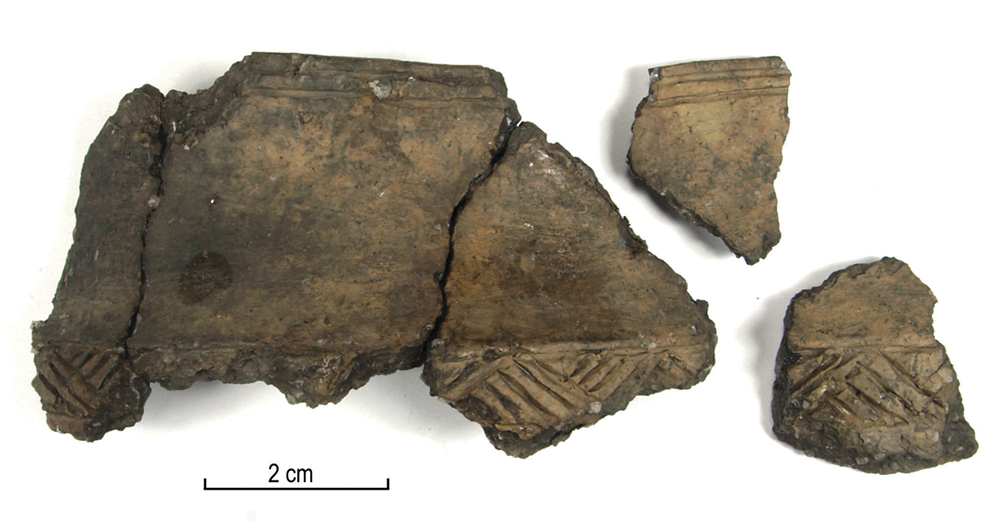
Fig. 2. Viking Age pottery shards from Tornimäe (AI 6688: 186). Photo by Heidi Luik.
2 pav. Tornimäe gyvenvietėje rastos vikingų laikotarpio keramikos šukės (AI 6688: 186). Heidi Luik nuotrauka
Animal bones from Tornimäe
The osteological material of Tornimäe is poorly preserved and mostly consists of small fragments. The total of 2537 mammal bones and bone fragments were identified to the species level. The majority of them, 1961 bones, come from the excavations in 2004. It was possible to identify 465 and 117 mammal bones from the osteological material gathered in 1963 and 1968, respectively. Bones form the excavations in 1963 have been already sorted by someone, presumably quite soon after the excavations – the bones were placed in boxes by species, only a few fragments are unidentifiable. It is not possible to say whether smaller, unidentifiable bone fragments were not preserved, or they were not picked up during the excavations.
The majority of mammal bones in the material of all excavations are bones of domestic animals – 86.7–91.5% of all identified mammal bones. Seal bones make up 6.8–12.5% and terrestrial wild game are represented with only a few examples, making up 0.8–1.1% of mammal bones (Fig. 3).
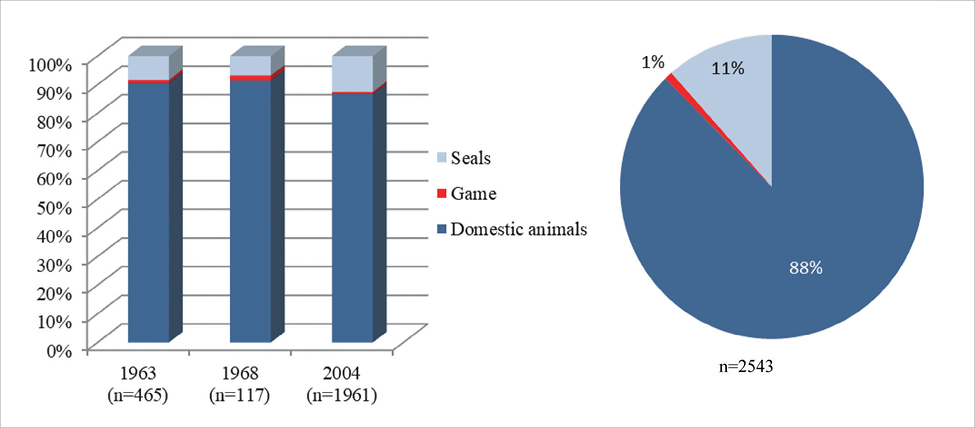
Fig. 3. Ratio of mammal bones in 1963, 1968 and 2004 (left) and total (right). Figure by Liina Maldre.
3 pav. Naminių ir laukinių gyvūnų dalis 1963, 1968, 2004 m. zooarcheologinėje medžiagoje ir apibendrinus visų metų tyrimus. Liina Maldre paveikslas
The most numerous are caprine (Ovis aries / Capra hircus) bones with the share in the range of 43.5–49.2% of all identified domestic animal bones. This is to be expected because the landscape of Saaremaa is naturally suitable for sheep and goat breeding. Bovine (Bos taurus) bones make up 31.6–42.3% and pig (Sus domesticus) bones 10.0–15.1% of the identified domestic animal bones. Horse (Equus caballus) bones were most numerous among the bones from the excavations in 1968 where they account for as much as 10.3% of domestic animal bones, but this is probably accidental and rather due to the small amount of material. Among bones from the excavations in 1963 and 2004 horse bones make up 4.3 and 4.1% respectively (Fig. 4).
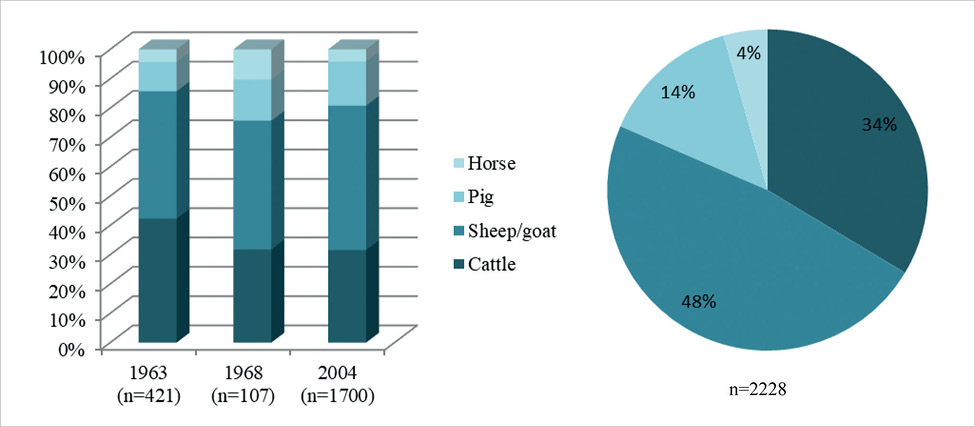
Fig. 4. Ratio of domestic animal bones in 1963, 1968 and 2004 (left) and total (right). Figure by Liina Maldre.
4 pav. Naminių gyvulių rūšinis pasiskirstymas 1963, 1968 ir 2004 m. zooarcheologinėje medžiagoje ir apibendrinus visų metų tyrimus. Liina Maldre paveikslas
Compared with the osteological material from other Estonian Viking Age settlements and hill forts, the ratio of different domestic animals in Tornimäe seems to resemble most closely the osteological material from the settlement of Linnaaluste, but the number of identified bones is rather small there (n = 312: Maldre, 2012, fig. 5.14). In most Viking Age sites of Estonia caprine bones do not have such a large proportion. On the other hand, the proportion of horse bones is significantly higher in most of the analysed Viking Age sites (Maldre, 2007, p. 62, fig. 2; 2012, fig. 5.14).
The analysis of the anatomical composition of domestic animal bones in Tornimäe shows that all body parts are represented. Skeletal elements are presented in five groups on the graph: bones of head, bones of trunk, bones of the proximal part of limbs, bones of the middle part of limbs and bones of the distal part of limbs (Fig. 5). The significant predominance of the bones of the head area is due to the large number of teeth, which is characteristic of the fragmented material. Thus, it is a typical settlement material consisting of both food and slaughter waste.
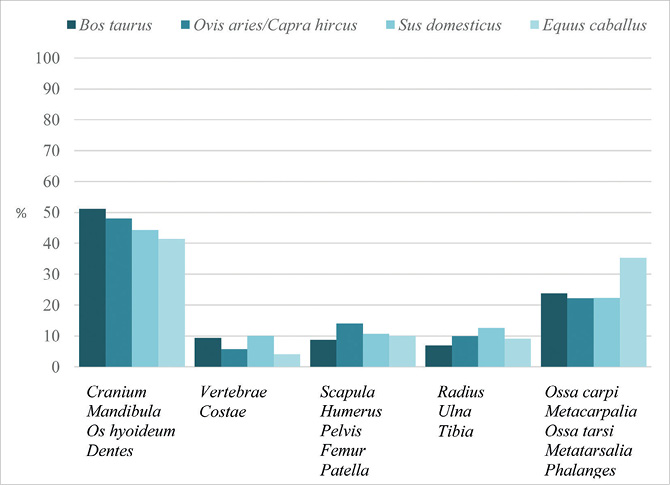
Fig. 5. Anatomical composition of domestic animal bones. Figure by Liina Maldre.
5 pav. Naminių gyvulių kaulų anatominis pasiskirstymas. Liina Maldre paveikslas
The inhabitants of the Tornimäe site were also involved in hunting, although to quite a small extent. The main focus has been on seal hunting; hunting for terrestrial wild animals has probably been of very little importance (Fig. 3). The species composition of seal bones is not yet analysed, but the anatomical composition is more or less representative of the bones of all body regions. Seal bones are represented also in some Viking Age sites in North Estonia which are not far from the sea: Iru and Pada (Maldre, 2007, p. 74–75, fig. 11; 2012, p. 122–123, fig. 5.16). Nevertheless, seal bones are still less numerous there, and these sites were also not located directly by the sea.
Of the terrestrial game, there appears to be a wild boar (Sus scrofa) represented among bones from all excavations. Among the bones of 1963, one elk (Alces alces) phalanx and one bear (Ursus arctos) phalanx were identified. A tooth of unspecified mustelid and ten bones of white hare (Lepus timidus) were among the bone material of 2004, at least eight of the latter coming from the left hind paw of the same hare. Bones of elk and beaver (Castor fiber), which are the main identified wild species in the other Viking Age sites are represented by a single bone or totally absent in Tornimäe (Maldre, 2007, p. 74–75; 2012, p. 123–124, fig. 5.17). The occurrence of beaver in Saaremaa in the Late Iron Age, including the Viking Age, is questionable, since no beaver bones have been found at the sites of these periods (Maldre, 2012, p. 124).
Bird and fish bones are also represented in Tornimäe. At least 236 bird bones have been found (50 in 1963, 22 in 1968 and 164 in 2004), but these bones have not been analysed yet. The vast majority of fish bones – more than 4500 bones (including fish scales) – were found in 2004; in 1963 and 1964 only 18 and 11 fish bones were discovered. This can be explained by the fact that no screening was used in these earlier excavations. Bones were collected by dry sieving on 5 mm mesh in Tornimäe in 2004 (Lõugas, 2016, p. 112). Not the whole assemblage of fish bones has been analysed, but preliminary results which are based on ca 1000 identified specimens are published by Lembi Lõugas (2016). All identified bones belong to freshwater fish. Perch (Perca fluviatilis) bones are most abundant, ide (Leuciscus idus), pike (Esox lucius) and various cyprinids (Cyprinidae) are also represented and also a few bones of pikeperch (Sander lucioperca). No marine species, like herring, cod or flounder have been identified (Lõugas, 2016, p. 112, fig. 11.2). The composition of fish bones is similar also at Pöide hill fort, located about 6 km west from Tornimäe (Fig. 1). The assemblage of fish bones in Pöide is very small, but all the fish species identified are of freshwater origin (Lõugas, 2001, p. 131; 2016, p. 112, fig. 11.2).
Finds from Tornimäe
The finds from archaeological excavations in Tornimäe belong mainly to the second half of the first millennium and the beginning of the second millennium AD, but later objects were also found in the upper part of the cultural layer (Mägi, 2005, p. 71–72).
Most of finds from Tornimäe, both pottery shards, and also bone objects, are preserved as quite small fragments (Fig. 6, 7). Only a few bone artefacts were among the finds. Ten artefacts and bone pieces with working traces were among the finds of the excavations in 1963, and only two items, which were called ’bone pins’ in the list of the finds, were among the finds from 2004. A few dozens of unworked bone fragments were also picked up among the finds. More fragments of worked bones were found by one of the authors of the present paper, Liina Maldre, among the animal bones during the identification of osteological material: altogether 24 artefact fragments and bone pieces with working traces. So, the question is: what could be possible to find out about the activities in the settlement site from such fragmentary material?
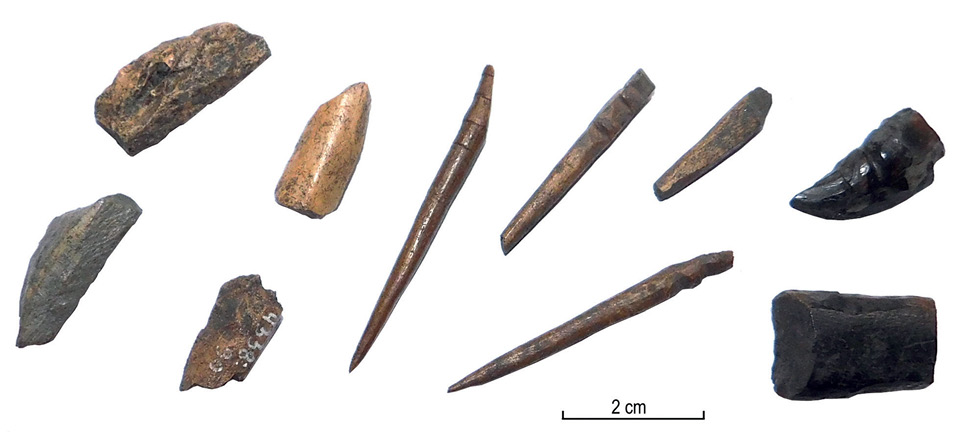
Fig. 6. Bone objects from Tornimäe, found in 1963 (AI 4338). Photo by Heidi Luik.
6 pav. Kauliniai dirbiniai, rasti Tornimäe gyvenvietės tyrimų metu 1963 m. (AI 4338). Heidi Luik nuotrauka
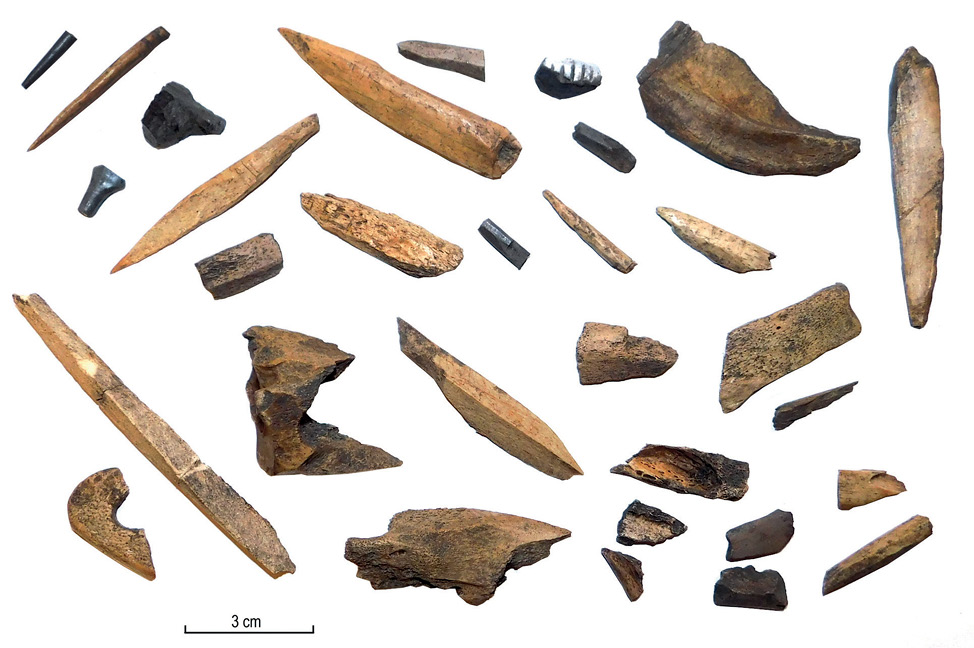
Fig. 7. Bone objects from Tornimäe, found in 2004 (AI 6688). Only two small points in the left upper corner were among the artefacts, other objects were noticed during the identification of animal bones. Photo by Heidi Luik.
7 pav. Kauliniai dirbiniai, rasti Tornimäe gyvenvietės tyrinėjimų metu 2004 m. (AI 6688). Tiktai du antgaliai (viršuje kairėje) aptikti tarp dirbinių, likusieji rasti atliekant zooarcheologinės medžiagos tyrimus. Heidi Luik nuotrauka
Bone fragments with working traces indicate that bone artefacts were made at the site. The number of such working waste is still quite small. The bone artefacts found in Tornimäe are rather simple items which do not require special skills from the bone worker and could have been made by the users of these artefacts. Almost all waste is bone fragments, only one is a tooth with cutting traces and one is a piece of antler. Since most worked bones are preserved very fragmentarily it was possible to identify only a few of them. Most of the identified bones are fragments of long bones: metatarsals and metacarpals. A radius and a mandible were also identified. In five cases the species of cattle and in two cases horse has been identified. Other long bone fragments also come from the bones of large herbivores, most likely cattle. The mentioned mandible fragment is a cattle left lower mandible coronoid process (Processus coronoideus). One worked fragment is a caprine bone. It is not possible to identify the antler fragment, but most likely it is elk antler.
Although the finds are not numerous and are preserved quite fragmentarily, there are similarities with bone objects from other Viking Age sites in Estonia, in particular with finds from settlement sites of Pada, Linnaaluste and Iru, and the hill fort of Tartu (e.g. Lang, 1996; Tvauri, 2001; Luik & Maldre, 2005a; Luik, 2012). Finds from Otepää and Rõuge, located in south-eastern Estonia, are somewhat different, because antler has been used more often as raw material in these sites (Luik, 2005, p. 35–37; Luik & Maldre, 2005b). Nevertheless, since bone artefacts are more numerous at these sites than in Tornimäe, the finds are more diverse there and several artefact types are represented which are absent in Tornimäe. On the other hand, certain small bone points with oblique end which are characteristic to Tornimäe, are unknown at other sites, at least among bone objects found so far.
Some bone fragments with working traces could have been simple ad hoc points, used for example as awls (Fig. 8). Similar quite roughly worked bone (and also antler) points have been found also from other Viking Age sites and hill forts in Estonia (Lang, 1996, pl. VIII: 8–9; Tvauri, 2001, p. 159–160, fig. 79; Luik & Maldre, 2005a, fig. 5; Luik, 2012, fig. 4.8).
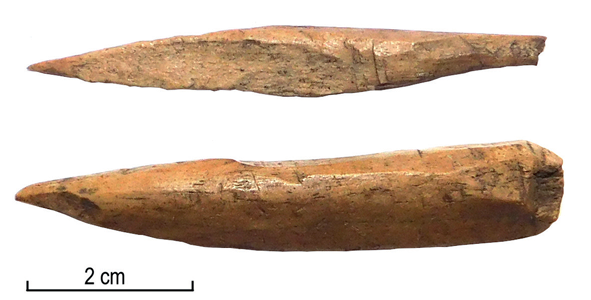
Fig. 8. Two bone points from Tornimäe (AI 6688: L 304, L 308). Photo by Heidi Luik.
8 pav. Tornimäe gyvenvietėje rasti antgaliai (AI 6688: L 304, L 308). Heidi Luik nuotrauka
One burnt fragment has parallel sawn lines (Fig. 9: 1). It may be a fragment of a simple double comb, similar to those found for example from the Valjala hill fort in Saaremaa and Otepää in South-East Estonia (Fig. 9: 2, 3; e.g. Luik, 1998, p. 47–58, fig. 24–29). Fragments of burnt bone combs have been found from some cremation burials in Saaremaa and West Estonia (Luik, 2003, p. 159–160, fig. 4). Double one-piece combs have been often made of antler, so it is possible that the fragmentary item from Tornimäe is also from antler, but since the object is burned, it is not certain.
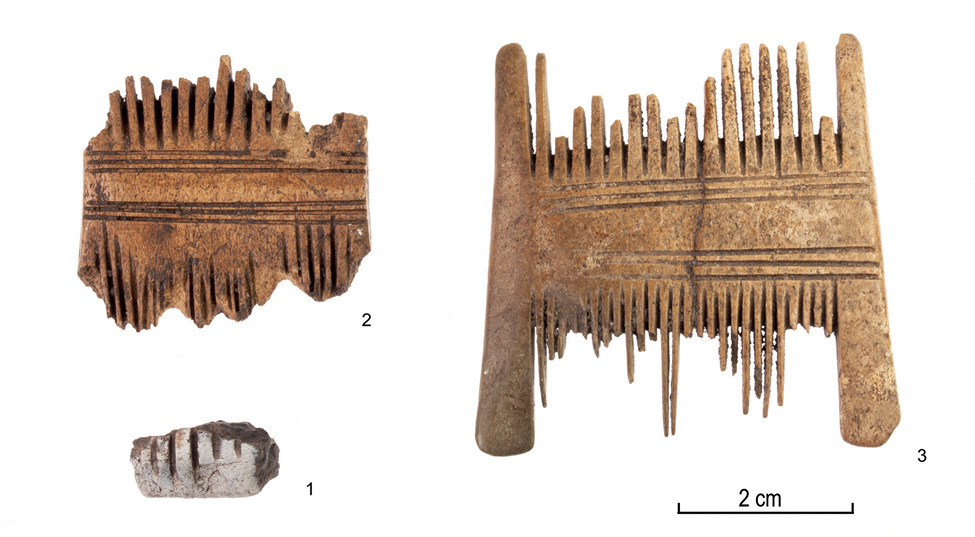
Fig. 9. A small burned fragment with sawn lines (1) (AI 6688: L 384) may be a fragment of a comb, presumably similar with double simple combs found e.g. from Valjala (2) and Otepää (3) (AI 4300: 533, 4036 I: 2176d). Photo by Jaana Ratas.
9 pav. Nedidelis apdegęs kaulinio dirbinio su įpjovomis fragmentas – greičiausiai šukų dalis (1) (AI 6688: L 384). Panašios dvipusės šukos rastos Valjala (2) ir Otepää (3) gyvenvietėse (AI 4300: 533, 4036 I: 2176d). Jaana Ratas nuotrauka
Small bone points – fish hooks
Some points found from Tornimäe are quite similar to each other: these are small thin points having another bevel end with small cuts at the opposite side (Fig. 10). There are four better preserved points and also some fragments and some worked bone pieces that could be unfinished points.
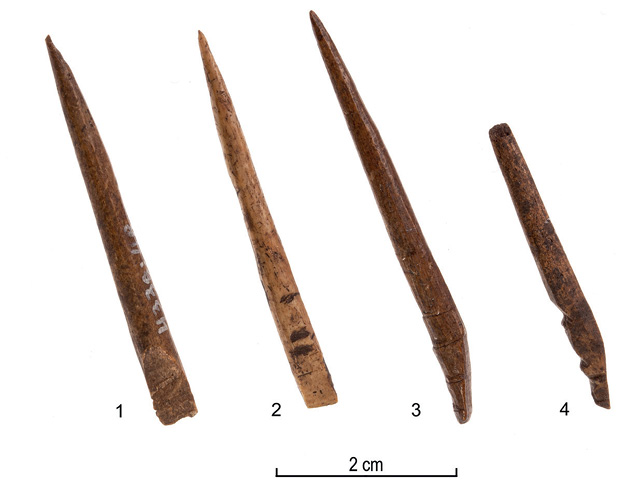
Fig. 10. Small bone points from Tornimäe (AI 4338: 48 (1), 6688: 146 (2), 4338: 945 (3), 240 (4)). Photo by Jaana Ratas.
10 pav. Tornimäe gyvenvietėje rasti nedideli antgaliai (AI 4338: 48 (1), 6688: 146 (2), 4338: 945 (3), 240 (4)). Jaana Ratas nuotrauka
It seems most likely that these points could have been parts of some fishing equipment. Small double pointed bone implements – gorges – were used for fishing already in the Stone Age, but also still in the Viking Age and even in later periods (e.g. Brinkhuizen, 1983, p. 11–13, 33–34, fig. 4, 40; Zagorska, 1991, fig. 2: 37–39; 5: 17–18; Riddler, 2006, p. 171–172, fig. 1; Biermann, 2008, p. 249, fig. 8). According to Ian Riddler (2006, p. 172) such gorges remain quite scarce in the early medieval period and, at least in the English context, they are mostly associated with riverine rather than coastal environments. A string was tied around the centre of the bone point and it was hidden into a small fish meant for bait (e.g. Sirelius, 1906, fig. 240: a; Torke, 1993, fig. 4, 5). It was fixed so that when the fish swallows it and tightens the string, the gorge turns transversely (Brinkhuizen, 1983, p. 11; van Vilsteren, 1987, p. 30, fig. 19; Riddler 2006, p. 171). However, the pointed objects from Tornimäe have a somewhat different shape.
The shape of these points suggests that these may have been spikes of some composite tool, presumably a fish hook. The bevel end ensured that the point was attached at the correct angle and the notches cut into it helped to hold better the string or leather strip used for binding. Composite fish hooks were used at different times and places since the Stone Age (e.g. Zagorska, 1994, p. 138, fig. 5; Galili et al., 2013, fig. 3; Biermann, 2008, p. 248–249; Allen et al., 2016, fig. 14.4: C). Composite fish hooks have been found for example from Lake Lūbana and also from Dviete in Latvia (Zagorska, 1991, fig. 5: 22, 23; 1994, fig. 5: 1, 8). The stem and the tip of the fish hooks were fastened together with plant fibres or tendons. One such hook with a fully preserved binding of a rope and the remains of a resinous coating was found at Dviete (Zagorska, 1991, fig. 5: 23). Bone fish hooks have been found from the Netherlands and Scandinavia, both from marine and freshwater contexts, but there are no certain examples of early medieval date (Brinkhuizen, 1983, p. 34–35, fig. 42; Riddler, 2006, p. 175). Fish hooks and their parts were often found in water bodies, both in lakes and rivers and also in the sea, where it is not possible to date them according to the find context (e.g. Brinkhuizen, 1983, p. 34).
Fish hooks found from the Viking Age sites in Estonia, and also neighbouring areas are usually made from metal (mostly iron, but also bronze) (e.g. Aun, 1992, p. 58–59, pl. XXII; Tvauri, 2012, fig. 65; Mugurēvičs, 2008, p. 242, pl. IX: 11–13, 17, 20).
In Finland composite wooden and bone fish hooks were used still in the end of the 19th century and the beginning of the 20th century (Fig. 11). The stem of the hook was usually made of wood, but the hook was either from wood (e.g. juniper), bone, but also from copper or iron wire (Sirelius, 1906, p. 90–92, fig. 207–208; Brinkhuizen, 1983, p. 13–15, fig. 8). In some case both the stem and the hook were made from bone (Sirelius, 1906, fig. 207: g). Small fish was attached to the hook as a bait (Fig. 11); according to Sirelius such hooks were used for catching burbot (Lota lota), pike (Esox lucius), pikeperch (Sander lucioperca) and salmon (Salmo salar) (Sirelius, 1906, p. 92, fig. 240: d, 241: a–c). As mentioned above, bones of two of these species – pike and pikeperch – are also represented among fish bones found in Tornimäe. Presumably similar hooks were used also in the Viking Age – the small points found from Tornimäe suit well to be parts of such composite fish hooks. If the stem was made from wood, the small bone point would be the only part to preserve from such a hook.
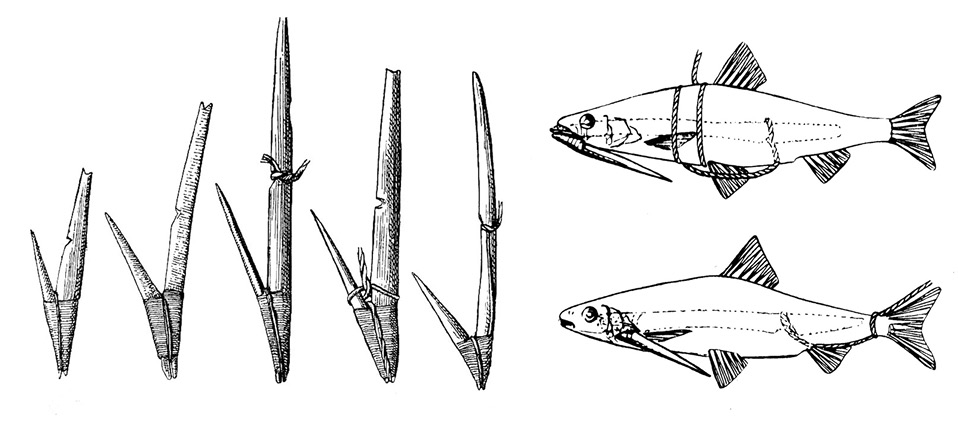
Fig. 11. Composite fish hooks from Finland and some examples how small fish were used as a bait, attached to the hook (Sirelius, 1906, fig. 207: f–k, 241: a, b).
11 pav. Suomijoje naudoti sudėtiniai žvejybos kabliukai ir jų naudojimas su nedidele žuvele (Sirelius, 1906, pav. 207: f–k, 241: a, b)
Fragments of bone skates
Another group of bone items from Tornimäe are bone fragments with one side carefully polished (Fig. 12). In cases it was possible to identify the used material, they have been made from cattle and horse bones. Most of these objects are quite fragmentary, but some of them have arcs left by the edges of holes made through the bones, indicating that they may be fragments of bone skates (Fig. 13). Presumably other pieces with polished surfaces are also skate fragments. According to identified bones, the fragments originate from at least four skates. Two of these were made from cattle bones – one from metacarpus and the other from metatarsus, the other two are horse bones, again one metacarpus and the other metatarsus. It was not possible to identify the material of other fragments. However, these smaller fragments may also be pieces of some of the identified skates. For example, one fragment of three matching pieces (Fig. 12, top right) was found close to a presumable skate fragment identified as horse bone (Fig. 12, top left).
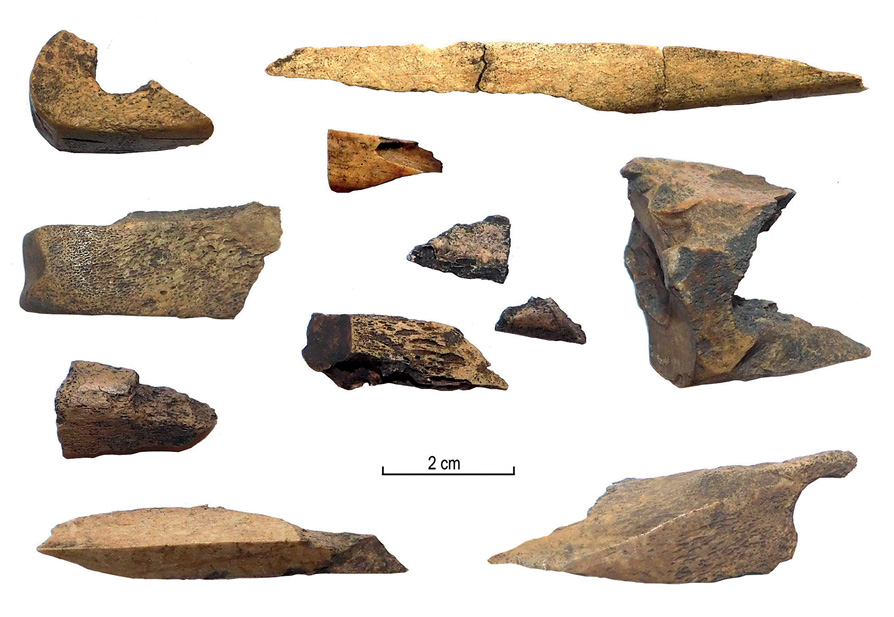
Fig. 12. Bone fragments with facets and arcs as traces of holes found among animal bones, presumably fragments of skates (AI 6688). Photo by Heidi Luik.
12 pav. Tarp zooarcheologinės medžiagos rasti dirbinių fragmentai gludintu paviršiumi ir su skylių žymėmis – greičiausiai pačiūžų liekanos (AI 6688). Heidi Luik nuotrauka
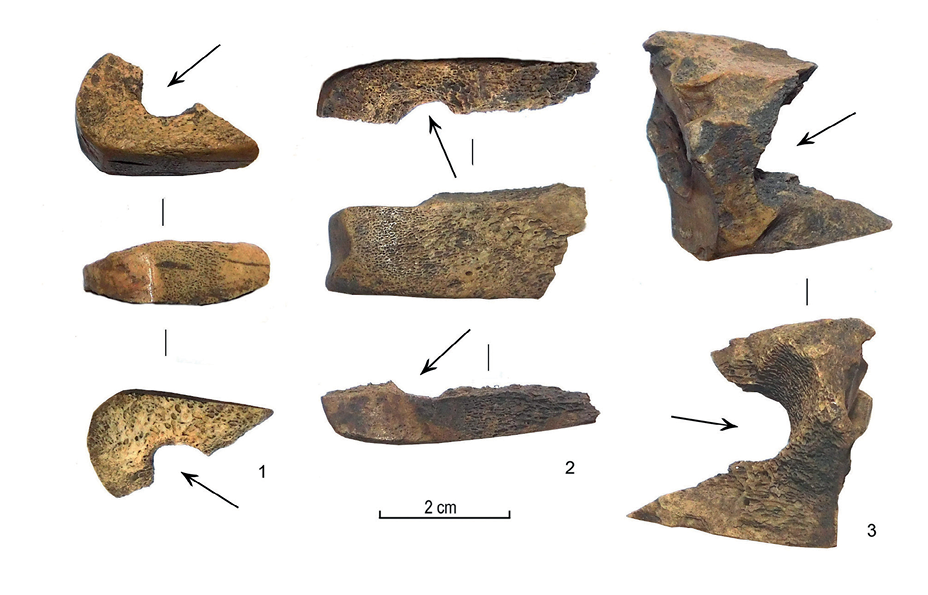
Fig. 13. Probable skate fragments: horse metacarpus (1) (AI 6688: L 696), cattle metacarpus (2) (AI 6688: L 775), horse metatarsus (3) (AI 6688: L 876). Arrows show the arcs as traces of holes at the ends of the skates. Photo by Heidi Luik.
13 pav. Spėjamų pačiūžų fragmentai: arklio plaštakos kaulo (1) (AI 6688: L 696), galvijo plaštakos kaulo (2) (AI 6688: L 775), arklio pėdos kaulo (3) (AI 6688: L 876). Rodyklėmis pažymėtos pačiūžų galuose buvusių skylių žymės. Heidi Luik nuotrauka
The earliest bone skates in Estonia known to date have been found from Viking Age sites. These skates have transverse holes at both ends and are usually made of horse bones (Fig. 14; Lang, 1996, pl. IX: 7; Luik, 2000, p. 131–133, fig. 2–3; Luik & Maldre, 2005a, fig. 2). Skates are known also from the Final Iron Age and medieval sites, but these differ from the earlier skates for having no holes; in some coastal areas of North-West Estonia bone skates were used still in the 19th century and beginning of the 20th century (Luik, 2000, p. 133–134, 143–144, fig. 5, 6, 10–14; 2002, p. 316–317, fig. 9, 10). Also in neighbouring areas and further, skates are known from many Viking Age as well as medieval and later sites (Vilppula, 1941; Berg, 1943; MacGregor, 1976; 1985; Ulbricht, 1984; Luik, 2000; Küchelmann & Zidarov, 2005; Tilko, 2005; Edberg & Karlsson, 2015; 2016).
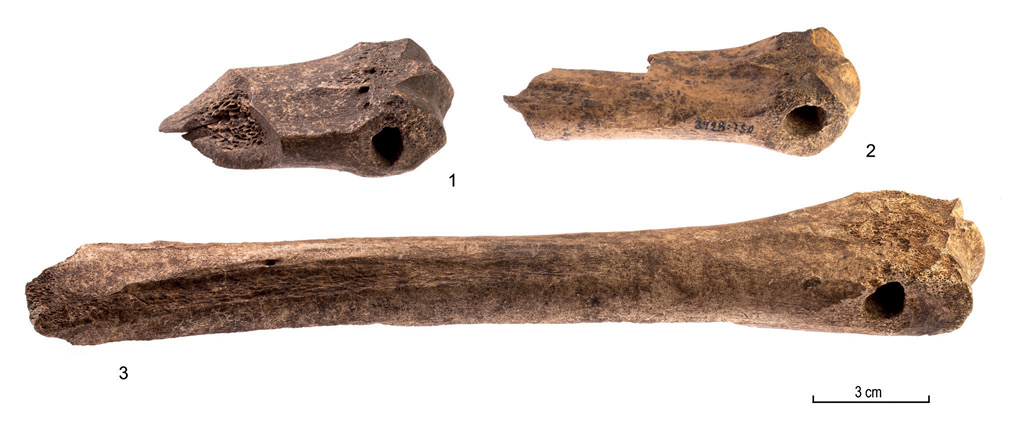
Fig. 14. Broken bone skates from Kuusalu (1), Iru (2) and Pada (3) Viking Age sites (AI 5043: 245, 3428: 750, 5082: 261). Photo by Jaana Ratas.
14 pav. Sulūžusios kaulinės pačiūžos iš vikingų laikotarpio Kuusalu (1), Iru (2) ir Pada (3) gyvenviečių (AI 5043: 245, 3428: 750, 5082: 261). Jaana Ratas nuotrauka
Several researchers have compared use wear on the artefacts made of horse and cattle long bones to interpret the function of these artefacts, since such bones were also suitable for making various tools, like textile or leather smoothers, fish-net weights-stiffeners etc. (Barthel, 1969; MacGregor, 1975; 1985, p. 141–144; Becker, 1990; Choyke & Bartosiewicz, 2005, p. 323–324; Arndt, 2006, p. 193, fig. 16). Fragments found in Tornimäe have use wear on their smooth facets, indicating their use as skates (Fig. 15–17; compare e.g. MacGregor, 1975, fig. 2, 3; 1985, fig. 75; Becker, 1990, fig. 4; Choyke & Bartosiewicz, 2005, fig. 6; Küchelmann & Zidarov, 2005, fig. 13).
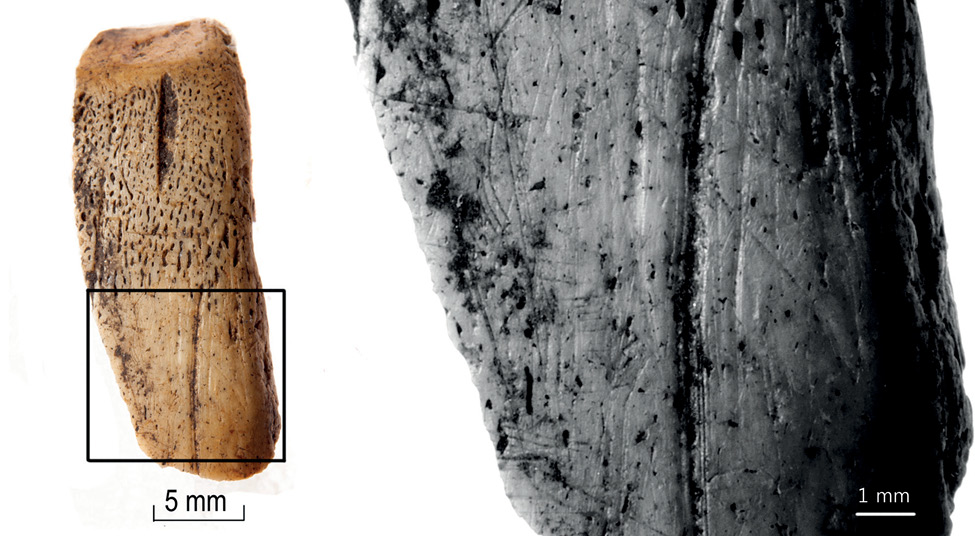
Fig. 15. Use wear on a presumable skate fragment (front end of the skate) (AI 6688: L 696). Photos by Jaana Ratas.
15 pav. Spėjamos pačiūžos fragmento (priekio) darbinės žymės (AI 6688: L 696). Jaana Ratas nuotrauka
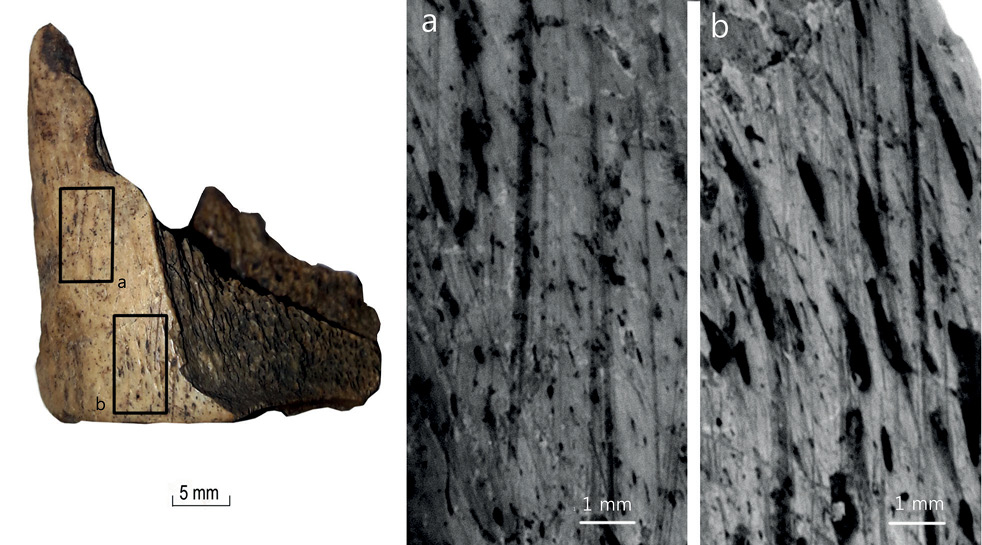
Fig. 16. Use wear on a presumable skate fragment (back end of the skate) (AI 6688: L 876). Photos by Heidi Luik and Jaana Ratas.
16 pav. Spėjamos pačiūžos fragmento (galo) darbinės žymės (AI 6688: L 876). Heidi Luik ir Jaana Ratas nuotraukos
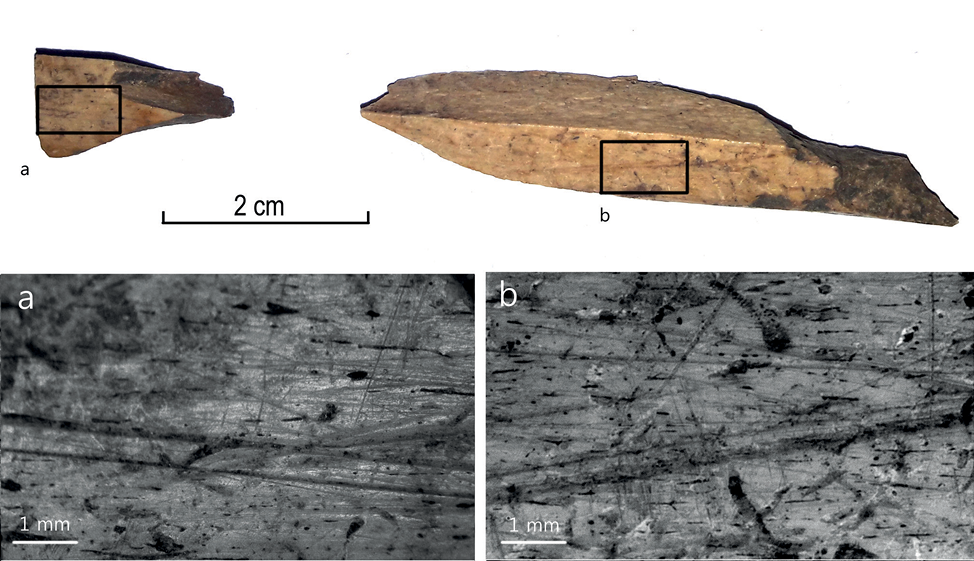
Fig. 17. Use wear on faceted bone fragments (presumable skate bases) (AI 6688: L 739, L 846). Photos by Heidi Luik, Aive Viljus and Jaana Ratas.
17 pav. Kaulų gludintu paviršiumi, greičiausiai pačiūžų liekanų, darbinės žymės (AI 6688: L 739, L 846). Heidi Luik, Aive Viljus ir Jaana Ratas nuotraukos
Discussion and conclusions
The osteological material indicates that mostly domestic animals were used for food. Goat and sheep, for the breading of which Saaremaa had favourable natural conditions, have a particularly large share. Hunting was not important, only a few bones of wild terrestrial animals have been found. Seal bones are more numerous, which is related to the location of the site on the coast. There are quite a lot of fish bones among the found material, all these are freshwater fish that could also be caught in the coastal waters.
The found worked bone fragments refer to three activities: bone working, fishing and skating. According to bone working waste only simple bone objects that need just slight working have been made on spot. For example, the skates could have been made even by children (MacGegor et al., 1999, p. 2005). The only more complicated artefact, the presumable comb, most likely has been brought from elsewhere, not made in Tornimäe. No bone or antler working waste indicating comb making was found in Tornimäe.
The found bone artefacts – details of fish hooks and skate fragments – suit well with the location of the site by the sea. According to the research made by Lembi Lõugas (2016, p. 112) in the eastern Baltic Sea region mostly freshwater fish were caught in the Viking Age, and also, although to a lesser degree, local marine fish in inshore waters. Among the fish bones identified among osteological material found in Tornimäe the same species (pike, perchpike) are represented, which according to Sirelius (1906, p. 92) were caught with composite fish hooks in Finland in the end of the 19th century to beginning of the 20th century.
It is assumed that bone skates were used by hunters and fishermen in the Viking Age, although in later times they were rather children’s toys (Berg, 1943; MacGregor, 1976, p. 65; 1985, p. 144; Luik, 2000, p. 146; Küchelmann & Zidarov, 2005, p. 440–441). In the opinion of Rune Edberg and Johnny Karlsson (2016, p. 15) the Viking Age and medieval skates found at Birka and Sigtuna were rather used by children and youth for leisure and sports, although it was possible to use skates by fishermen also. In both early written sources and also in later times descriptions about games and competitions dominate (MacGregor, 1976, p. 61–63; Edberg & Karlsson, 2016, p. 11–13; cf. e.g. Olaus Magnus, 1996/1998, p. 57–58; Russwurm, 1855, p. 107). Whether a skate could belong to a child or an adult can be decided on the basis of its length (Cinthio, 1976, p. 385; MacGegor et al., 1999, p. 1989; Edberg & Karlsson, 2016, p. 10–11, 14), but as the specimens found in Tornimäe have been preserved only fragmentarily, there is no information about their length.
No constructions that could be directly connected with a harbour were detected during the excavations (Mägi, 2010, p. 171). Marika Mägi still mentions some earlier descriptions about the remains of a ‘wooden palisade’ found by local peasants when ploughing on the slope, which in her opinion could have been a part of the harbour construction (Mägi, 2010, p. 171). Mägi (2005, p. 70) has drawn attention to the fact that no remains of ovens were found in the excavation plots both in 1963 and 2004. Remains of hearths were found some time ago by local people when building a house foundation, and also during the archaeological excavations in 1963 and 2004, but these cannot be interpreted as oven remnants (Tiitsmaa, 1922, p. 22; Kustin, 1967, p. 4–6; Mägi, 2005, p. 69–70, fig. 4). Mägi assumed that this may indicate the seasonal use of the buildings in Tornimäe. If the site was a harbour location, primarily used during summer months the lack of ovens may be explained because of no need for heating. Mägi still notes that the excavated area is not sufficient in size for drawing far-reaching conclusions and there could be dwelling houses with ovens in other parts of the site (Mägi, 2005, p. 70). In the case of activities, where found bone objects were used, fishing with hooks could take place both during the ice-free period and during the winter on ice. The skates, however, suggest that the site was inhabited also in winter. It is possible, of course, that only some of the buildings were in use during the winter, and that there were more dwellers in the settlement during the ice-free period when the ships and boats could land in the harbour.
Acknowledgements. We would like to thank Giedrė Piličiauskienė for inviting us to the conference “Investigating bones: diet, health, environment in the Baltic region”, and Estonian Cultural Endowment for financial support to participate at this conference. We are thankful to László Bartosiewicz and Kerstin Lidén for valuable comments and advice, to Helle Solnask for her help with English and to Jaana Ratas and Aive Viljus for their help with illustrations.
Abbreviation:
AI – Archaeological research collection of Tallinn University
Manuscripts
Kustin A. 1967. Aruanne Tornimäe asula kaevamisest 1963. aastal. Manuscript at the Archaeological research collection of Tallinn University.
Kustin A. 1968. Aruanne Tornimäe muinasasula arheoloogilisest kaevamisest 1968. a. Manuscript at the Archaeological research collection of Tallinn University.
Tiitsmaa A. 1922. Pöide kihelkonna kirjeldus. Manuscript at the Archaeological research collection of Tallinn University.
Literature
Allen H., Langley M. C. & Taçon P. S. C. 2016. Bone projectile points in Prehistoric Australia: Evidence from archaeologically recovered implements, ethnography, and rock art. M. C. Langley (ed.) Osseous Projectile Weaponry: Towards an Understanding of Pleistocene Cultural Variability. Dordrecht: Springer, p. 209–218. https://doi.org/10.1007/978-94-024-0899-7_14
Arndt B. 2006. Archäologische Befunde zum Handwerk im mittelalterlichen Göttingen. M. Gläser (Hrsg.) Das Handwerk. Lübecker Kolloquium zur Stadtarchäologie im Hanseraum, V. Lübeck: Verlag Schmidt-Römhild, p. 183–197.
Aun 1992 = Аун M. Археологические памятники второй половины 1-го тысятчелетия н. э. в Юго-Восточной Эстонии. Таллинн: Олион.
Barthel H.-J. 1969. Schlittknochen oder Knochengeräte? G. Behm-Blancke (Hrsg.) Alt-Thüringen. Jahresschrift des Museums für Uhr- und Frühgeschichte Thüringens, 10, 1968/1969. Weimar: Hermann Böhlaus Nachfolger, p. 205–227.
Becker C. 1990. Bemerckungen über Schlittknochen, Knochenkufen und ähnliche Artefacte, unter besonderer Berücksichtigung der Funde aus Berlin-Spandau. J. Schibler, J. Sedlmeier & H. Spycher (Hrsg.) Festschrift für Hans R. Stampfli. Beiträge zur Archäozoologie, Archäologie, Anthropologie, Geologie und Paläoantologie. Basel: Helbing & Lichtenhahn, p. 19–30.
Berg G. 1943. Isläggar och skridskor. Fataburen. Nordiska Museets och Skansens Arsbok. Stockholm, p. 79–90.
Biermann F. 2008. Die Knochen- und Geweihbearbeitung im nordwestslawischen Siedlungsgebiet vom 7./8. bis 12. Jahrhundert n. Crh. W. Melzer (Hrgs.) Archäologie and mittelalterliches Handwerk – Eine Standortbestimmung. Beiträge des 10. Kolloquiums des Arbeitskreises zur archäologischen Erforschung des mittelalterlichen Handwerk. Soester Beiträge zur Archäologie, 9. Soest: Westfälische Verlagsbuchhandlung Mocker & Jahn, p. 239–266.
Brinkhuizen D. C. 1983. Some notes on recent and Pre- and Protohistoric fishing gear from northwestern Europe. Palaeohistoria, 25, p. 7–54. https://doi.org/10.1201/9781003079248
Choyke A. M. & Bartosiewicz L. 2005. Skating with horses: continuity and parallelism in prehistoric Hungary. Revue de Paléobiologie, 10, p. 317–326.
Cinthio, M. 1976. Isläggar. A. W. Mårtensson (ed.) Uppgrävt förflutet för PKbanken i Lund. En investering i arkeologi. Archaeologia Lundensia. Investigationes de antiqvitatibus Lundae, VII. Lund: Kulturhistoriska museet, p. 383–385.
Edberg R. & Karlsson J. 2015. Isläggar från Birka och Sigtuna. En undersökning av ett vikingatida och medeltida fyndmaterial. Stockholm Archaeological Reports, 43. Stockholm: Stockholms universitet.
Edberg R. & Karlsson J. 2016. Bone skates and young people in Birka and Sigtuna. Fornvännen, 111, p. 7–16.
Galili E., Zemer A. & Rosen B. 2013. Ancient fishing gear and associated artifacts from underwater explorations in Israel – a comparative study. Archaeofauna, 22, p. 145–166.
Küchelmann H. C. & Zidarov P. 2005. Let’s skate together: skating on bones in the past and today. H. Luik, A. M. Choyke, C. E. Batey & L. Lõugas (eds.) From Hooves to Horns, from Mollusc to Mammoth. Manufacture and Use of Bone Artefacts from Prehistoric Times to the Present. Proceedings of the 4th meeting of the ICAZ Worked Bone Research Group at Tallinn, 26th–31st of August 2003. Muinasaja teadus, 15. Tallinn, p. 425–445.
Lang V. 1996. Muistne Rävala. Muistised, kronoloogia ja maaviljelusliku asustuse kujunemine Loode-Eestis, eriti Pirita jõe alamjooksu piirkonnas, I–II. Muinasaja teadus, 4. Tallinn.
Lõugas L. 2001. Development of fishery during the 1st and 2nd millennia AD in the Baltic region. Journal of Estonian Archaeology, 5/1, p. 28–47.
Lõugas L. 2016. Fishing and fish trade during the Viking Age and Middle Ages in the eastern and western Baltic Sea regions. J. H. Barrett & D. Orton (eds.) Cod and Herring: The Archaeology and History of Medieval Sea Fishing. Oxford: Oxbow Books, p. 111−116.
Luik H. 1998. Muinas- ja keskaegsed luukammid Eestis. Muinasaja teadus, 6. Tallinn.
Luik H. 2000. Luust uisud Eesti arheoloogilises leiumaterjalis. Journal of Estonian Archaeology, 4/2, p. 129–150.
Luik H. 2002. Luuesemed Lihula keskaegsest alevikust ja linnusest. V. Lang (ed.) Keskus – tagamaa – ääreala. Uurimusi asustushierarhia ja võimukeskuste kujunemisest Eestis. Muinasaja teadus, 11. Tallinn, Tartu, p. 301–348.
Luik H. 2003. Luuesemed hauapanustena rauaaja Eestis. V. Lang & Ü. Tamla (eds.) Arheoloogiga Läänemeremaades. Uurimusi Jüri Seliranna auks. Muinasaja teadus, 13. Tallinn, Tartu, p. 53–172.
Luik H. 2005. Luu- ja sarvesemed Eesti arheoloogilises leiumaterjalis viikingiajast keskajani / Bone and Antler Artefacts among Estonian Archaeological Finds from the Viking Age until the Middle Ages. Dissertationes archaeologiae Universitatis Tartuensis, 1. Tartu: Tartu Ülikooli Kirjastus.
Luik H. 2012. Bone artefacts from the Keava hill fort and Linnaaluste settlement sites. V. Lang (ed.) Keava – „The Hand of the Sun“. Estonian Journal of Archaeology. Supplementary Series, 1. Tallinn: Estonian Academy Publishers, p. 92–105. https://doi.org/10.3176/arch.2012.supv1.05
Luik H. & Maldre L. 2005a. Bone and antler artefacts from the settlement site and cemetery of Pada in North Estonia. H. Luik, A. M. Choyke, C. E. Batey & L. Lõugas (eds.) From Hooves to Horns, from Mollusc to Mammoth. Manufacture and Use of Bone Artefacts from Prehistoric Times to the Present. Proceedings of the 4th meeting of the ICAZ Worked Bone Research Group at Tallinn, 26th–31st of August 2003. Muinasaja teadus, 15. Tallinn, p. 263–276.
Luik H. & Maldre L. 2005b. Bone and antler-working on the hillfort and settlement site at Rõuge (last quarter of thge 1st millennium AD. H. Luik. Luu- ja sarvesemed Eesti arheoloogilises leiumaterjalis viikingiajast keskajani / Bone and Antler Artefacts among Estonian Archaeological Finds from the Viking Age until the Middle Ages. Dissertationes archaeologiae Universitatis Tartuensis, 1. Tartu: Tartu Ülikooli Kirjastus. Supplement I.
MacGregor A. 1975. Problems in the interpretation of microscopic wear patterns: the evidence from the bone skates. Journal of Archaeological Science, 2, p. 385–390. https://doi.org/10.1016/0305-4403(75)90009-6
MacGregor A. 1976. Bone skates: a review of the evidence. Archaeological Journal, 133, p. 57–74. https://doi.org/10.1080/00665983.1976.11020453
MacGregor A. 1985. Bone, Antler, Ivory and Horn. The Technology of Skeletal Materials since the Roman Period. London: Croom Helm. https://doi.org/10.4324/9781315747668
MacGregor A., Mainman A. J. & Rogers N. S. H. 1999. Craft, Industry and Everyday Life: Bone, Antler, Ivory and Horn from Anglo-Scandinavian and Medieval York. The Archaeology of York. The Small Finds, 17/12. York: York Archaeological Trust.
Mägi M. 2002. Piirkonnad ja keskused. Asustus muinasaja lõpu ja varakeskaegsel Saaremaal arheoloogiliste, inimgeograafiliste ning ajalooliste allikate andmeil. V. Lang (ed.) Keskus – tagamaa – ääreala. Uurimusi asustushierarhia ja võimukeskuste kujunemisest Eestis. Muinasaja teadus, 11. Tallinn, Tartu, p. 169–232.
Mägi M. 2005. Viking Age harbour site at Tornimäe, Eastern Saaremaa. Archaeological Fieldwork in Estonia 2004, p. 65–75.
Mägi M. 2010. Trade, war and the diversity of rituals at late prehistoric harbour sites on Saaremaa. Archaeologia Baltica, 14, p. 168–182.
Maldre L. 2007. Faunal remains from the settlement site of Pada. Estonian Journal of Archaeology, 11/1, p. 59–79.
Maldre L. 2012. Archaeozoological material from the settlement sites at Linnaaluste and the hill fort at Keava. V. Lang (ed.) Keava – „The Hand of the Sun“. Estonian Journal of Archaeology. Supplementary Series, 1. Tallinn: Estonian Academy Publishers, p. 106–126. https://doi.org/10.3176/arch.2012.supv1.06
Mugurēvičs Ē. 2008. Viduslaiku ciems un pils Salaspils novadā. Rīga: Latvijas Vēstures Institūta Apgāds.
Olaus Magnus 1996/1998. Historia de Gentibus Septentrionalibus. Romæ 1555. Description of the Northern Peoples. Rome 1555. Vol. I–III. Translated by P. Fisher & H. Higgens, ed. P. Foote. London: The Hakluyt Society.
Riddler I. 2006. Early medieval fishing implements of bone and antler. M. Pieters, F. Verhaeghe & G. Gevaert (eds.) Trade and Piracy: Fishermen and Fishermen’s Settlements in and around the North Sea Area in the Middle Ages and Later. Archaeologie in Vlaanderen, 6. Brussels: Archeologie in Vlaanderen, p. 171–180.
Russwurm C. 1855. Eibofolke oder die Schweden an der Küsten Ehstlands und auf Runö, 2. Reval.
Sirelius U. T. 1906. Suomalaisten kalastus, I. Helsinki: Suomalaisen Kirjallisuuden Seura.
Tilko S. 2005. Kaula slidas Rīgas arheoloģiskaja materiālā. A. Caune (ed.) Senā Rīga. Pētījumi pilsētas arheoloģijā un vēsturē, 5. Rīga: Latvijas Vēstures Institūta Apgāds, p. 135–152.
Torke W. 1993. Die Fischerei am prähistorischen Federsee. Archäologisches Korrespondenzblatt, 23/1, p. 49–66.
Tvauri A. 2001. Muinas-Tartu. Uurimus Tartu muinaslinnuse ja asula asustusloost. Muinasaja teadus, 10. Tartu, Tallinn.
Tvauri A. 2012. The Migration Period, Pre-Viking Age, and Viking Age in Estonia. Estonian Archaeology, 4. Tartu: Tartu University Press. https://doi.org/10.26530/OAPEN_423944
Ulbricht I. 1984. Die Verarbeitung von Knochen, Geweih und Horn im mittelalterlichen Schleswig. Ausgrabungen in Schleswig. Berichte und Studien, 3. Neumünster: Wachholtz.
Van Vilsteren V. T. 1987. Het Benen Tijdperk. Gebruiksvoorwerpen van been, gewei, hoorn en ivoor 10.000 jaar geleden tot heden. Assen: Drents Museum.
Vilppula H. 1941. Luuluistimista. Suomen Museo, XLVII, 1940, p. 51–58.
Zagorska I. A. 1991 = Загорска И. А. Рыболовство и морской промысел в каменном веке на территории Латвии. Н. Н. Гурина (ред.) Рыболовство и морской промысел в эпоху мезолита – раннего металла в лесной и лесостепной зоне Восточной Европы. Ленинград: Наука, p. 39–64.
Zagorska I. 1994. Saliktie makšķerāķi Latvijas arheoloģiskajā materiālā. Arheoloģija un Etnogrāfija, 17, p. 129–138.
Gyvūnų kaulai ir kauliniai dirbiniai iš vikingų laikotarpio Tornimäe gyvenvietės Saremos saloje
Heidi Luik, Liina Maldre
Santrauka
Tornimäe gyvenvietė yra rytinėje Saremos salos dalyje (1 pav.). Nors dabar ji yra apie 2 km nutolusi nuo jūros, vikingų laikotarpiu gyvenvietė buvo pačioje pakrantėje ties gilia, jūriniams laivams plaukioti tinkama vieta. Archeologiniai tyrinėjimai gyvenvietėje vykdyti 1963, 1968 ir 2004 m., jų metu aptikta vikingų laikotarpio radinių. Daugiausia tai keraminių indų šukės (2 pav.), taip pat keletas stiklinių karoliukų, metalinių ir kaulinių dirbinių. Be to, rasta nemažai žinduolių bei žuvų kaulų.
Iki rūšies lygio identifikuoti 2 537 žinduolių kaulai ir jų fragmentai, tarp kurių naminių gyvulių liekanos sudarė 88 %, ruonių kaulai – 11 %, kitų laukinių gyvūnų kaulai – vos 1 % (3 pav.). Beveik pusė naminių gyvulių kaulų priklausė avims / ožkoms, galvijų, kiaulių ir arklių kaulų aptikta mažiau (4 pav.). Anatominė gyvūnų kaulų analizė parodė, kad aptikta įvairių skeleto dalių (5 pav.). Gyvenvietėje rastų paukščių kaulų tyrimai dar neatlikti. Iki galo neištirta ir žuvų kaulų kolekcija, tačiau preliminariais duomenimis, identifikavus apie 1 000 kaulų fragmentų, visi jie priklauso gėlavandenėms žuvims.
Kauliniai dirbiniai išlikę fragmentiškai (6, 7 pav.), dauguma jų identifikuoti atliekant osteologinės medžiagos analizę. Kaulo apdirbimo liekanos rodytų, kad dirbiniai gaminti gyvenvietėje. Kaip įrankiai galėjo būti naudojami ir kai kurie neapdirbti kaulų fragmentai (8 pav.) – jie naudoti tiesiog kaip ylos (ad hoc tipo dirbiniai). Vienas apdegęs kaulo fragmentas su lygiagrečiomis įraižomis greičiausiai buvo paprastų dvipusių šukų dalis (9 pav.).
Viena didesnė dirbinių grupė – antgalių tipo dirbiniai. Jie yra labai panašūs – nedideli, siauri dirbinukai, įstrižai nupjauta apatine dalimi su smulkiomis įpjovomis jai priešingoje pusėje (10 pav.). Dirbinių forma rodytų, kad tai sudedamoji įrankio, greičiausiai žvejybos kabliuko, dalis, jo smaigas. Sudėtiniai žvejybos kabliukai buvo plačiai naudojami jau nuo akmens amžiaus. Suomijoje tokie mediniai ir kauliniai kabliukai naudoti iki pat XIX a. pabaigos–XX a. pradžios (11 pav.). Panašūs kabliukai naudoti ir vikingų laikotarpiu, o kauliniai Tornimäe gyvenvietėje rasti smaigai greičiausiai ir yra tokių sudėtinių žvejybos kabliukų dalys.
Kita kaulinių dirbinių grupė yra jų fragmentai stipriai nugludinta viena puse (12 pav.), dalis jų – su buvusių skylių žymėmis. Skylės rodytų, kad tokie fragmentai greičiausiai yra pačiūžų liekanos (13 pav.). Ankstyviausios kaulinės pačiūžos Estijoje žinomos iš vikingų laikotarpio gyvenviečių (14 pav.). Kadangi panašūs fragmentai gali būti ne tik pačiūžų, bet ir kitų dirbinių, pavyzdžiui, odai ir tekstilei minkštinti naudotų įrankių, tinklų pasvarų įtvarų ir kt. liekanos, siekiant išsiaiškinti tokio tipo dirbinių paskirtį buvo atlikti jų darbinių žymių tyrimai. Gauti rezultatai parodė, kad Tornimäe gyvenvietėje aptikti kaulinių dirbinių fragmentai gludintu paviršiumi turi specifines, pačiūžoms būdingas naudojimo žymes, o tai leidžia juos interpretuoti kaip pačiūžas (15–17 pav.).
Tornimäe gyvenvietėje rasti kaulinių dirbinių fragmentai yra siejami su trejopa veikla – kaulo apdirbimu, žvejyba ir čiuožinėjimu. Kaulo apdirbimo atliekos rodo, kad dirbiniai gaminti vietoje, jie buvo paprasti, nesudėtingai apdirbti. Tyrinėta gyvenvietė buvo įsikūrusi pajūryje, o joje aptiktos kabliukų dalys ir pačiūžų fragmentai atspindi čia vykdytas veiklas bei gyventojų poreikius. Tyrinėtame gyvenvietės plote nebuvo rasta jokių krosnių liekanų, kas galėtų rodyti, kad pakrantėje gyventa sezoniškai: tai galėjęs būti vasaros uostas, todėl namai tiesiog nebuvo šildomi. Kadangi kauliniai kabliukai gali būti naudojami įvairiais metų laikais, jų radimas šiai prielaidai neprieštarautų. Kita vertus, pačiūžų liekanos rodytų, kad čia gyventa ir šaltuoju metų laiku. Tikėtina, kad gyvenvietė naudota ištisus metus – žiemą joje gyveno mažiau žmonių, naudoti tiktai kai kurie pastatai, o šiltuoju sezonu, kai pakrantėje galėdavo prisišvartuoti laivai ir valtys, čia gyvendavo gerokai daugiau gyventojų.